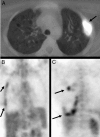Utility of [18F]2-fluoro-2-deoxyglucose-PET in sporadic and tuberous sclerosis-associated lymphangioleiomyomatosis
- PMID: 19349386
- PMCID: PMC3198490
- DOI: 10.1378/chest.09-0336
Utility of [18F]2-fluoro-2-deoxyglucose-PET in sporadic and tuberous sclerosis-associated lymphangioleiomyomatosis
Abstract
Mutations in tuberous sclerosis complex (TSC) genes are associated with dysregulated mammalian target of rapamycin (mTOR)/Akt signaling and unusual neoplasms called perivascular epithelioid cell tumors (PEComas), including angiomyolipomas (AMLs) and lymphangioleiomyomatosis (LAM). Tools that quantify metabolic activity and total body burden of AML and LAM cells would be valuable for the assessment of disease progression and the response to therapy in patients with TSC and LAM. Our hypothesis was that constitutive activation of mTOR in LAM and AML cells would result in increased glucose uptake of [(18)F]2-fluoro-2-deoxyglucose (FDG) on PET scanning, as has been suggested by a single prior case report. After institutional review board approval, FDG-PET scanning was performed in six LAM patients. Six additional LAM patients underwent FDG-PET scanning for clinical evaluation of suspected malignancy. Pleural uptake related to prior therapy was identified in four individuals with a remote history of talc pleurodesis. Focal increased uptake was observed in a supraclavicular lymph node in a patient with Hodgkin lymphoma and in a lung nodule in a patient with a biopsy-documented primary lung adenocarcinoma. In one TSC-LAM patient with a biopsy-documented malignant uterine PEComa, robust uptake was noted in metastatic nodules in the lung but not in the LAM-involved lung parenchyma or the patient's massive abdominal lymphangioleiomyomas. No abnormal uptake was identified in the AMLs or LAM lesions in any patients. This pilot study suggests that FDG-PET scans are negative in patients with benign PEComas and therefore are not likely to be useful for estimating the burden of disease in patients with TSC or LAM, but that FDG-PET scans can be used to identify or exclude other neoplasms in these patients.
Figures






References
-
- Costello LC, Hartman TE, Ryu JH. High frequency of pulmonary lymphangioleiomyomatosis in women with tuberous sclerosis complex. Mayo Clin Proc. 2000;75:591–594. - PubMed
-
- Franz DN, Brody A, Meyer C, et al. Mutational and radiographic analysis of pulmonary disease consistent with lymphangioleiomyomatosis and micronodular pneumocyte hyperplasia in women with tuberous sclerosis. Am J Respir Crit Care Med. 2001;164:661–668. - PubMed
-
- Moss J, Avila NA, Barnes PM, et al. Prevalence and clinical characteristics of lymphangioleiomyomatosis (LAM) in patients with tuberous sclerosis complex. Am J Respir Crit Care Med. 2001;164:669–671. - PubMed
-
- van Slegtenhorst M, de Hoogt R, Hermans C, et al. Identification of the tuberous sclerosis gene TSC1 on chromosome 9q34. Science. 1997;277:805–808. - PubMed
-
- Consortium ECTS. Identification and characterization of the tuberous sclerosis gene on chromosome 16: the European Chromosome 16 Tuberous Sclerosis Consortium. Cell. 1993;75:1305–1315. - PubMed
MeSH terms
Substances
LinkOut - more resources
Full Text Sources
Medical
Miscellaneous

